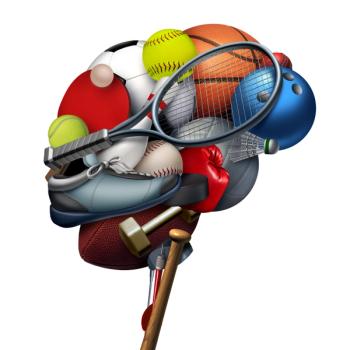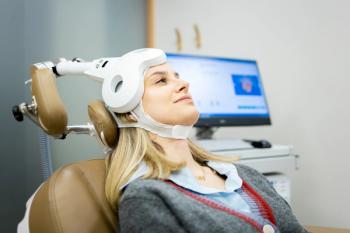
- Vol 38, Issue 12
TMS: A Useful Clinical Tool for Treatment-Resistant Depression
How can transcranial magnetic stimulation help patients with treatment-resistant depression?
Developed in 1985 and approved by the US Food and Drug Administration in 2008, transcranial magnetic stimulation (TMS) technology has been gaining clinical interest as an effective treatment option for patients with treatment-resistant depression. Two-thirds of TMS patients experienced either full remission of their depression symptoms or noticeable improvements.1 TMS is a noninvasive outpatient procedure without serious adverse effects, making it an attractive option for patients who have not found relief from other treatments, including psychopharmacology and psychotherapy.
How TMS Works
TMS uses an alternating current passed through a metal coil placed against the scalp to generate rapidly alternating magnetic fields. These pass through the skull nearly unimpeded and induce electric currents that depolarize neurons in a focal area of the surface cortex.
The magnetic field generated by TMS is comparable to that of a standard magnetic resonance imaging device (MRI), measured at approximately 1.5 to 3 Teslas. However, the TMS field is focal (beneath the coil), whereas the MRI field is large and fills the room housing the MRI device.
One hypothesis on how TMS works is that the stimulation of discrete cortical regions alters pathologic activity within a network of gray matter brain regions, specifically those involved in mood regulation and connected to the targeted cortical sites.2 Functional imaging studies support this hypothesis by showing TMS can change activity in brain regions remote from the site of stimulation.3,4
TMS has many molecular effects comparable to electroconvulsive therapy (ECT), including increased monoamine turnover and normalization of the hypothalamic pituitary axis.5 However, unlike ECT, TMS does not require general anesthesia and is not associated with impaired cognition. Additionally, in one neuroimaging study of depressed patients, a prefrontal serotonin deficiency at baseline normalized after treatment with TMS.
High-frequency stimulation is thought to excite the targeted neurons and is typically used to activate the left prefrontal cortex. Low-frequency stimulation appears to inhibit cortical activity and is usually directed at the right prefrontal cortex.
Consistent with this hypothesis, a review examined 66 studies in patients with depression who were treated with TMS targeting the dorsolateral prefrontal cortex. It found that high-frequency TMS generally increased regional cerebral blood flow, whereas low-frequency TMS generally decreased regional cerebral blood flow, which is reduced in a depressed brain.6
When Is TMS a Good Option?
TMS is indicated for patients with unipolar major depression who have failed at least 1 antidepressant medication. In addition, TMS is indicated for patients who responded to a prior course of TMS.7 Its use for these patients is consistent with treatment guidelines from the American Psychiatric Association, Canadian Network for Mood and Anxiety Treatments, and the Royal Australian and New Zealand College of Psychiatrists.
The patient evaluation should confirm the primary diagnosis of treatment-resistant depression and determine whether the TMS intervention can be used safely. The assessment includes examinations of psychiatric history, general medical history, physical health, and mental status with emphasis upon depressive symptoms. This should emphasize risk factors for seizures and preexisting neurologic disease, such as epilepsy, intracranial masses, and vascular abnormalities.
TMS is contraindicated in patients with: increased risks for seizures, implanted metallic hardware (aneurysm clips, bullet fragments, etc), cochlear implants, implanted electrical devices (pacemakers, intracardiac lines, medication pumps, etc), and unstable general medical disorders. The
How Effective Is TMS?
Multiple reviews have found consistent evidence that TMS provides a clinically relevant benefit to patients with treatment-resistant depression. In patients with acute major depression who have not responded to at least 1 antidepressant medication, numerous meta-analyses of randomized trials have found TMS superior to placebo treatment.8-11 It is not known if maintenance treatment with TMS for unipolar major depression is beneficial.
A meta-analysis of 34 randomized trials compared TMS with placebo treatment in 1383 patients with treatment-resistant major depression. It found that improvement was greater with active treatment.12 Add-on treatment with TMS was efficacious in patients who had not responded to an adequate antidepressant therapy. Response (for example, the reduction of baseline symptoms ≥ 50%) occurred in more patients who received active (47%) versus placebo (22%) TMS.12
There have been no consistent predictors of response according to a meta-analysis. A 1-year, prospective observational study of 120 patients who responded or remitted with acute TMS found that the durability of response to TMS was not associated with age, sex, severity of depressive symptoms prior to TMS, nor the number of failed antidepressant trials prior to TMS.13
For treatment of major depression, TMS is less efficacious than ECT. Follow-up studies of patients with major depression who were treated acutely with TMS in randomized trials indicate that the short-term benefits of TMS are stable.14 With regard to longer-term benefits of TMS, prospective, observational studies lasting at least 6 months suggest that in patients with major depression who improve with acute TMS, relapse occurs in about 35%.15
For patients with unipolar major depression who improve with a course of TMS and subsequently deteriorate or relapse, reintroduction of TMS using the same stimulation parameters may be helpful.16 It is not known if maintenance treatment with TMS for unipolar major depression is beneficial, as few randomized trials using standard protocols have been conducted. However, in several small, observational studies of patients, the results suggest that maintenance TMS may, perhaps, be beneficial.7
How Safe Is TMS?
TMS is generally safe and well-tolerated. For example, in a randomized trial of 301 patients, investigators found that study discontinuation due to adverse effects was comparable for active and placebo TMS (5% and 3%, respectively).17
The most serious adverse effect of TMS is a generalized tonic-clonic seizure. However, the risk of seizure appears to be comparable to that for anti-depressant medications. Seizures probably occur in less than 0.1 to 0.5% of patients when safety guidelines are followed regarding patient selection and stimulation parameters. Seizures that have occurred were self-limited, required no medications, and did not recur.18 Factors that increase the risk of seizures can be found in the
Other effects include hypomania and mania, described in randomized trials17 and reports of patients with major depression (both unipolar and bipolar) who were treated with TMS.19,20
However, the clinical significance is not known, because patients with bipolar major depression can switch to mood-elevated states in the absence of an antidepressant treatment. Treatment of unipolar major depression with TMS does not appear to increase suicidal ideation or behavior.21
What About Side Effects?
Headache and scalp pain. A review of randomized trials in patients with major depression found that the incidence of headache with active treatment and placebo treatment was 28% and 16%, respectively. The incidence of scalp pain with active and placebo treatment was 39% and 15%, respectively. No migraine headaches have been reported. Headache and scalp pain may be more pronounced when higher stimulation frequencies and intensities are used. Topical lidocaine may reduce scalp pain. Reducing stimulation intensity can decrease scalp discomfort, but this can also reduce efficacy of treatment. For sensitive patients, the dose of TMS can be titrated up during the first week. Headache and scalp pain generally resolve over the first 2 weeks, although some patients may require an analgesic, such as acetaminophen or ibuprofen.22
Transient (< 4 hours) increase in auditory threshold. This is caused by repeated clicks that are produced as current passes through the stimulating magnetic coil and mechanically deforms the coil. Hearing loss is prevented with foam earplugs or noise protection ear coverings.
Vasovagal syncope. Management generally consists of reassurance.
Special Concerns
Elderly. For older patients with major depression, TMS can be beneficial if the stimulation intensity is sufficient.17 Prefrontal atrophy in older patients can increase the distance between the coil and cortex to the point that lower-intensity stimulation, which typically penetrates to a depth of 2 to 3 cm, does not affect cortical activity. Increasing the intensity above the motor threshold can overcome the added distance.5
Poststroke depression. Depression frequently occurs after stroke, and TMS may help these patients.
Pregnancy and postpartum depression. For these patients with major depression, observational studies suggest that TMS may possibly be safe and effective. It appears unlikely that the fetus is directly affected by TMS because magnetic fields rapidly attenuate with distance.23
Concluding Thoughts
TMS is an exciting and promising therapy that can provide real and lasting relief for patients with treatment-resistant depression. Conducted in an outpatient setting, TMS is a noninvasive procedure that is generally safe and well-tolerated. This provides patients with the flexibility to seek treatment in a way that does not disrupt their daily lives. TMS has an equally promising future, with studies exploring its expanded applications, as well as its use as an ongoing maintenance treatment.
Dr Ramanujam is a psychiatrist and regional medical director at
References
1. Carpenter LL, Janicak PG, Aaronson ST, et al.
2. Baeken C, De Raedt R.
3. Kito S, Fujita K, Koga Y.
4. Fitzgerald PB, Sritharan A, Daskalakis ZJ, et al.
5. George MS, Post RM.
6. Noda Y, Silverstein WK, Barr MS, et al.
7. Perera T, George MS, Grammer G, et al.
8. Schutter DJ.
9. Berlim MT, Van den Eynde F, Jeff Daskalakis Z.
10. Berlim MT, Van den Eynde F, Daskalakis ZJ.
11. Allan CL, Herrmann LL, Ebmeier KP.
12. Janicak PG, Dokucu ME.
13. Schutter DJ.
14. Kedzior KK, Reitz SK, Azorina V, Loo C.
15. Avery DH, Holtzheimer PE, Fawaz W, et al.
16. Liu B, Zhang Y, Zhang L, Li L.
17. Xia G, Gajwani P, Muzina DJ, et al.
18. Stultz DJ, Osburn S, Burns T, et al.
19. Dolberg OT, Schreiber S, Grunhaus L.
20. Garcia-Toro M.
21. Abdelnaim MA, Langguth B, Deppe M, et al.
22. O’Reardon JP, Solvason HB, Janicak PG, et al.
23. Rossi S, Hallett M, Rossini PM, et al.
24. Rossi S, Hallett M, Rossini PM,
Articles in this issue
almost 4 years ago
Challenges and Opportunities Beyond COVID-19almost 4 years ago
Moving Beyond the Enormity Problem: Tackling the Global Refugee Crisisalmost 4 years ago
Exploring the Global Consequences of the COVID-19 Pandemicalmost 4 years ago
Issues in Women’s Health: Global Lessons, Opportunities, and Challengesalmost 4 years ago
Exploring the Link Between Migraine and PTSDalmost 4 years ago
Social Determinants and Clinical Realitiesalmost 4 years ago
Temperature Checkalmost 4 years ago
Conference Presents Clinical Reviews and Updatesalmost 4 years ago
Lithium Neurotoxicity: The SILENT Syndromealmost 4 years ago
Current Health Care System Cannot Survive Aging PopulationNewsletter
Receive trusted psychiatric news, expert analysis, and clinical insights — subscribe today to support your practice and your patients.














